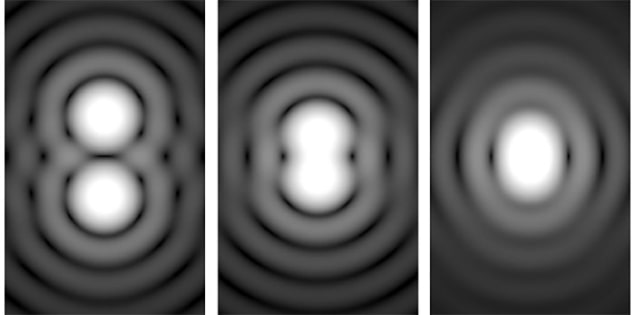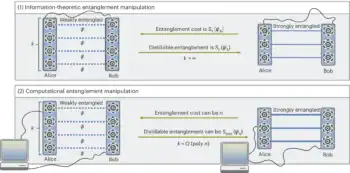
Scientists have long believed that diffraction limits the minimum distance that can be measured between two adjacent sources of light: if the distance is too short, then the sources appear as one. Now, however, engineers in Singapore have used quantum mechanics to show this not to be the case. The researchers say that new optical techniques based on their discovery might increase the resolving power of microscopes and telescopes by several orders of magnitude.
The resolution of any imaging device is limited by the wave nature of light. That is because light striking a device’s aperture – a lens or mirror, say – are diffracted. These waves arrive at different points on the aperture interfere to produce a diffraction pattern around each point in the image. If the diffraction maximum of one point lies within its neighbour’s minimum, then those two points appear to be merged and are said to be unresolved – a criterion laid down by Lord Rayleigh in the 19th century.
Cursed criterion
In the latest work, Mankei Tsang and colleagues at the National University of Singapore looked at how to measure the distance between two adjacent light sources that are so close that they violate Rayleigh’s criterion. At that point, noise caused by light’s quantum nature – where an image is built up from discrete photons arriving randomly – means the measurement becomes far more difficult with every tiny decrease in separation. The Singapore group has dubbed this problem “Rayleigh’s curse”.
To date, scientists have devised many clever techniques to essentially sidestep this problem. In microscopy, for example, the distance between fluorescent particles is kept to a manageable minimum by ensuring that only a small subset of particles emits at any one time. Astronomers, meanwhile, can sometimes use signal processing to resolve objects that are slightly closer than the Rayleigh criterion allows.
Tsang and co-workers instead used a theory known as “quantum metrology” to work out which physical measurements would yield the most information when carried out on light. In this way, they found it is possible to measure the distance between two light sources with an accuracy that doesn’t depend on how close the sources are to one another. Even when violating Rayleigh’s criterion, they discovered that the error on their measurements remains roughly constant as they reduce the distance, rather than skyrocketing as it does with existing techniques. “Our study shows that Rayleigh’s curse is not a fundamental limit,” says Tsang.
Various schemes
In addition to this result, the researchers also put forward schemes to implement their approach in practice. The key here was to find ways of separating the “useful parts” of the light from the “noisy parts”. In their current paper, published this week in Physical Review X (originally on the arXiv server last November), the group proposes carrying out this sifting using waveguides with spatially varying refractive indices. In a follow-up paper uploaded to the arXiv in December, and published in Optics Express two months later, they proposed a second scheme where incoming light interferes with its spatially inverted counterpart.
Both papers have already led four other groups – another at the National University of Singapore, two in Canada and one largely from the Czech Republic – to carry out experiments on similar schemes. All of the groups were able to overcome the Rayleigh limit, while two of them got to within a factor of two of the fundamental quantum limit identified by Tsang and colleagues. “Our schemes can easily be built using today’s technology, they just require low-loss dielectric optical components,” says Tsang. “People could have done this 20 years ago, if only they knew.”
Seth Lloyd of the Massachusetts Institute of Technology in the US is impressed. “This is awesome work and I am amazed that it hasn’t been done before,” he says. “Perhaps everyone thought it was too good to be true.”
Pushing limits
Currently, the team is concentrating on applying their work to fluorescence microscopy, which, says Tsang, is “the lowest hanging fruit”. However, the results may also have applications in astronomy, the most obvious of which would be astrometry – the meticulous measurement of stars’ positions and movements. The team is also in the process of generalising its theory to widen its application. By using the distance measurements to establish whether bright sources actually conceal multiple objects, he says, the work might become useful in detecting binary stars or hunting for exoplanets.
Tsang also points out that their findings could only be used to improve the performance of telescopes whose resolution is already at the point where it is limited by diffraction and quantum noise. This, he explains, will generally be true of space-based observatories, but on Earth will depend on a telescope’s precise specifications. “If a telescope’s adaptive optics is good enough to minimize the effect of turbulence, then there’s no question that our techniques can help,” says Tsang.
The latest research is published in Physical Review X.



